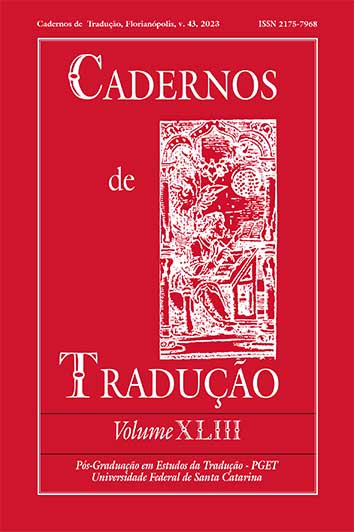'Love Hath Reason, Reason None': A New Brazilian Portuguese Translation of William Shakespeare's "The Phoenix and the Turtle"
DOI:
https://doi.org/10.5007/2175-7968.2023.e93085Keywords:
William Shakespeare, The Phoenix and the Turtle, Poetry translationAbstract
The purpose of this article is twofold: to present a new translation of William Shakespeare's poem “The Phoenix and the Turtle” alongside a discussion of formal and semantic solutions as well as to help filling the gap that exists in terms of translations of Shakespeare's lyrical poetry into Brazilian Portuguese, much smaller in number than those of the dramatic canon, except for the series of 154 sonnets (The Sonnets, 1609). It is a short poem, published in 1601 in a collection edited by Robert Chester under the title Love’s Martyr, which also includes authors such as Ben Jonson and George Chapman. In formal terms, it features 67 lines distributed in 13 quatrains and five triplets, to the latter making up the final part, the threnos. Written in trochaic tetrameter, it follows the rhyme scheme abba in the quatrains and aaa in the triplets. In an allegorical tone, it describes the ideal love between the phoenix and the turtle, which unites them into a single being, while preserving their own individualities. The poem begins with the gathering of some birds, such as crow, eagle and swan, to celebrate the memory of the phoenix and the turtle after their death. From the eleventh stanza on, Reason, personified, takes over the narrative, and sings a funereal lament for the love of the two birds: with their death, beauty, truth and grace disappear from the world. The translation presented here followed the method for the translation of poetry devised by Paulo Henriques Britto (2006, 2015), comprised of three steps: to identify the poetically significant characteristics of the poem; to assign a priority to each feature, depending on the greater or lesser contribution it makes to the overall aesthetic effect of the poem; and to recreate the characteristics considered to be the most significant among those for which correspondences can be sought in the target language. Replicating this method, the poem was recreated in eight-syllable lines, following the stanzaic structure and the rhyme scheme of Shakespeare’s poem.
References
Afonso, Leonardo. “A fênix e o pombo”. Página de Trabalho do Pesquisador Shakespeariano Leonardo Afonso. Janeiro de 2022. Disponível em: https://profleoafonso.wordpress.com/a-fenix-e-o-pombo/. Acesso em: 2 fev. 2023.
Britto, Paulo Henriques. “Correspondência formal e funcional em tradução poética”. In: Souza, Marcelo Paiva de; Carvalho, Raimundo & Salgueiro (org.). Sob o signo de Babel: literatura e poéticas da tradução. Vitória: PPGL-MEL/Flor&Cultura, 2006. p. 55-64. Disponível em: http://www.letras.puc-rio.br/media/filemanager/professores/paulo_britto/Britto%20-%20Correspondencia%20formal%20e%20funcional.pdf. Acesso em: 7 jul. 2023.
Britto, Paulo Henriques. “A reconstrução da forma na tradução de poesia”. Eutomia, 16(1), p. 102-117, 2015. Disponível em www.letras.puc-rio.br/media/filemanager/professores/paulo_britto/Reconstrucao%20da%20forma%20na%20traducao%20de%20poesia.pdf. Acesso em: 7 jul. 2023.
Burrow, Colin. “Introduction”. In: Burrow, Colin (ed.). William Shakespeare. The Complete Sonnets and Poems. Oxford: Oxford University Press, 2002. p. 1-169.
Chester, Robert (org.). Loves Martyr: Or, Rosalins Complaint. Allegorically Shadowing the truth of Love in the constant Fate of the Phoenix and Turtle. Londres, 1601. Digitalizado pela biblioteca da Universidade da Califórnia em Riverside.
Folgerpedia. Disponível em www.folgerpedia.folger.edu. Acesso em: 06 jan. 2023.
Greenblatt, Stephen (general editor); Cohen, Walter; Howard, Jean & Maus, Katharine Eisaman (ed.). The Norton Shakespeare, based on the Oxford Edition. 2. ed. Londres: Norton, 2008.
Grünewald, José Lino. “A magia de Shakespeare, para além do tempo”. O Estado de São Paulo, 10 mar. 1990. Disponível em: https://joselinogrunewald.com.br/literatura.php?id=536. Acesso em: 5 jan. 2023.
Grünewald, José Lino. “Shakespeare metafísico”. Jornal do Brasil, 23 abr. 1964. Disponível em: https://joselinogrunewald.com.br/traducoes.php?id=830. Acesso em: 5 jan. 2023.
Hyland, Peter. An Introduction to Shakespeare’s Poems. Nova York: Palgrave Macmillan, 2002.
Mendes, Oscar. “Nota introdutória”. In: Shakespeare, William. William Shakespeare: Obra completa. Volume III – Dramas históricos e Obras líricas. Tradução anotada de F. Carlos de Almeida Cunha Medeiros e Oscar Mendes. Rio de Janeiro: Companhia José Aguilar Editora, 1969. p. 735-737.
Motta, Thereza Christina Rocque da. “A Fênix e a Pomba (William Shakespeare)”. Blog de Thereza Christina Rocque da Motta. Rio de Janeiro, 1 maio 2012. Disponível em: http://therezachristinamotta.blogspot.com/2012/05/fenix-e-pomba-william-shakespeare.html. Acesso em: 2 fev. 2023.
Oxford English Dictionary. Second Edition on CD-ROM (v. 4.0). Oxford: Oxford University Press, 2009.
Post, Jonathan F. S. Shakespeare’s Sonnets and Poems – a Very Short Introduction. Oxford: Oxford University Press, 2017.
Roe, John (ed.). The Poems. Venus and Adonis, The Rape of Lucrece, The Phoenix and The Turtle, The Passionate Pilgrim, A Lover’s Complaint. Updated edition. Cambridge: Cambridge University Press, 2014.
Shakespeare, William. William Shakespeare – Obra Completa. Volume III – Dramas históricos e Obras líricas. Tradução anotada de F. Carlos de Almeida Cunha Medeiros e Oscar Mendes. Rio de Janeiro: Companhia José Aguilar Editora, 1969.
Downloads
Published
How to Cite
Issue
Section
License
Copyright (c) 2023 Cadernos de Tradução

This work is licensed under a Creative Commons Attribution 4.0 International License.
Copyright Notice
Authors hold the copyright and grant the journal the right for their articles' first publication, being their works simultaneously licensed under the Creative Commons Attribution License (CC BY), which allows the sharing of such works with its authorship acknowledged and its initial publication in this journal.
Authors are allowed to enter into separate additional contractual arrangements for the non-exclusive distribution of the journal's published version of the work (e.g., post it to an institutional repository or as a book chapter, with an acknowledgment of its initial publication in this journal).








































